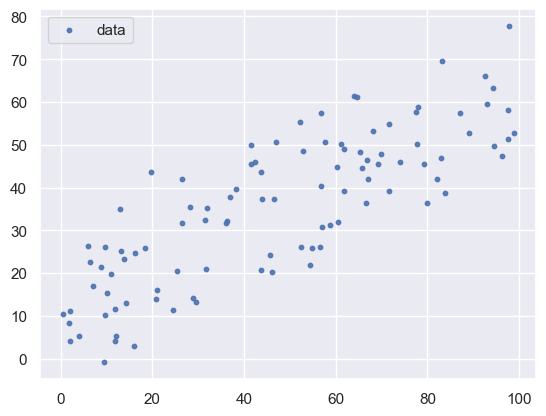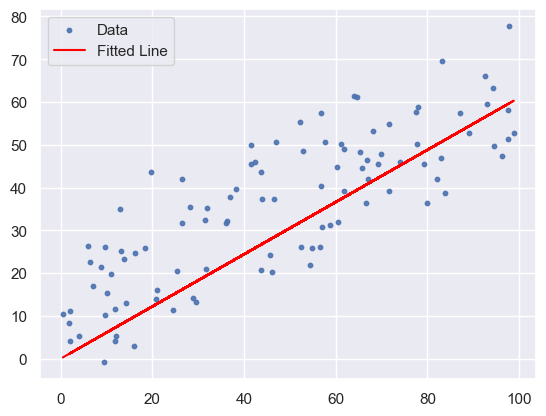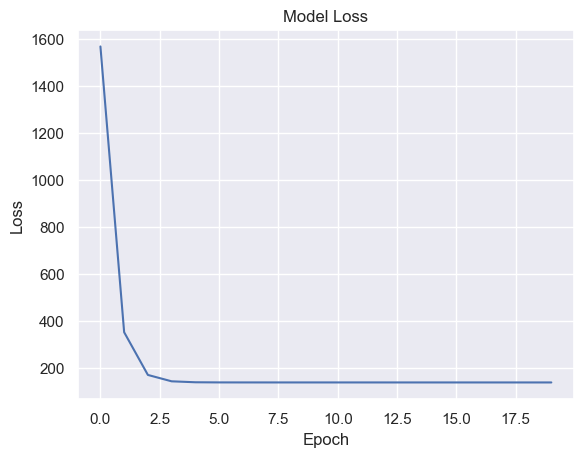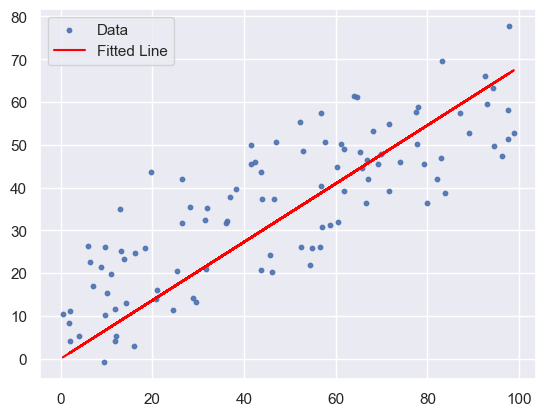Simple Linear Regression Model in PyTorch and Tensorflow
from numpy.random import uniform, normal
import numpy as np
np.set_printoptions(precision=4)
import matplotlib.pyplot as plt
%matplotlib inline
import seaborn as sns
sns.set()
np.random.seed(0) # Set seed for reproducibility
%precision %.4f
'%.4f'
# generate simulation data
n_sample = 100
a = 0.5
b = 10
sd = 10
X = uniform(0, 100, size=n_sample).astype(np.float32)
mu = a * X + b # linear predictor is a * x + b, link function is y=x
Y = normal(mu, sd) # Probability distribution is normal distribution
plt.scatter(X, Y, s=10, alpha=0.9, label='data')
#plt.ylim(0,80)
plt.legend()
<matplotlib.legend.Legend at 0x142c8fb90>

1. Linear Regression Model in Tensorflow
import tensorflow as tf
# Define the model
model = tf.keras.Sequential([
tf.keras.layers.Dense(1,
input_shape=(1,),
kernel_initializer='zeros',
bias_initializer='zeros'
)
])
# Compile the model
model.compile(optimizer=tf.keras.optimizers.SGD(learning_rate=0.0001),
loss='mean_squared_error')
# Train the model
history = model.fit(X, Y, epochs=10, shuffle=False, verbose=1)
Epoch 1/10
[1m4/4[0m [32m━━━━━━━━━━━━━━━━━━━━[0m[37m[0m [1m0s[0m 3ms/step - loss: 1161.4839
Epoch 2/10
[1m4/4[0m [32m━━━━━━━━━━━━━━━━━━━━[0m[37m[0m [1m0s[0m 2ms/step - loss: 165.0661
Epoch 3/10
[1m4/4[0m [32m━━━━━━━━━━━━━━━━━━━━[0m[37m[0m [1m0s[0m 2ms/step - loss: 160.1171
Epoch 4/10
[1m4/4[0m [32m━━━━━━━━━━━━━━━━━━━━[0m[37m[0m [1m0s[0m 2ms/step - loss: 160.0082
Epoch 5/10
[1m4/4[0m [32m━━━━━━━━━━━━━━━━━━━━[0m[37m[0m [1m0s[0m 2ms/step - loss: 159.9909
Epoch 6/10
[1m4/4[0m [32m━━━━━━━━━━━━━━━━━━━━[0m[37m[0m [1m0s[0m 1ms/step - loss: 159.9754
Epoch 7/10
[1m4/4[0m [32m━━━━━━━━━━━━━━━━━━━━[0m[37m[0m [1m0s[0m 2ms/step - loss: 159.9600
Epoch 8/10
[1m4/4[0m [32m━━━━━━━━━━━━━━━━━━━━[0m[37m[0m [1m0s[0m 1ms/step - loss: 159.9446
Epoch 9/10
[1m4/4[0m [32m━━━━━━━━━━━━━━━━━━━━[0m[37m[0m [1m0s[0m 2ms/step - loss: 159.9291
Epoch 10/10
[1m4/4[0m [32m━━━━━━━━━━━━━━━━━━━━[0m[37m[0m [1m0s[0m 2ms/step - loss: 159.9137
# Plot the loss over epochs
plt.plot(history.history['loss'])
plt.title('Model Loss')
plt.xlabel('Epoch')
plt.ylabel('Loss')
plt.show()

# Visualize the predictions
plt.scatter(X, Y, s=10, alpha=0.9, label='Data')
plt.plot(X, model.predict(X), color='red', label='Fitted Line')
plt.legend()
plt.show()

# Print the weights of the model
weights, biases = model.layers[0].get_weights()
print(f"Weights: {weights}, Biases: {biases}")
Weights: [[0.6098]], Biases: [0.0348]
2. Linear Regression Model in PyTorch
import torch
import torch.nn as nn
import torch.optim as optim
torch.manual_seed(0)
# Convert to PyTorch tensors
X_tensor = torch.tensor(X, dtype=torch.float32).view(-1, 1)
Y_tensor = torch.tensor(Y, dtype=torch.float32).view(-1, 1)
# Define the model
class LinearRegressionModel(nn.Module):
def __init__(self):
super(LinearRegressionModel, self).__init__()
self.linear = nn.Linear(1, 1)
nn.init.zeros_(self.linear.weight)
nn.init.zeros_(self.linear.bias)
def forward(self, x):
return self.linear(x)
model = LinearRegressionModel()
# Define the loss function and optimizer
criterion = nn.MSELoss()
optimizer = optim.SGD(model.parameters(), lr=0.0001)
# Train the model
num_epochs = 20
losses = []
for epoch in range(num_epochs):
model.train()
# Forward pass
outputs = model(X_tensor)
loss = criterion(outputs, Y_tensor)
# Backward pass and optimization
optimizer.zero_grad()
loss.backward()
optimizer.step()
losses.append(loss.item())
print(f'Epoch [{epoch+1}/{num_epochs}], Loss: {loss.item():.4f}')
Epoch [1/20], Loss: 1566.5591
Epoch [2/20], Loss: 352.8644
Epoch [3/20], Loss: 171.5089
Epoch [4/20], Loss: 144.4068
Epoch [5/20], Loss: 140.3534
Epoch [6/20], Loss: 139.7440
Epoch [7/20], Loss: 139.6492
Epoch [8/20], Loss: 139.6313
Epoch [9/20], Loss: 139.6249
Epoch [10/20], Loss: 139.6203
Epoch [11/20], Loss: 139.6158
Epoch [12/20], Loss: 139.6115
Epoch [13/20], Loss: 139.6071
Epoch [14/20], Loss: 139.6027
Epoch [15/20], Loss: 139.5983
Epoch [16/20], Loss: 139.5940
Epoch [17/20], Loss: 139.5896
Epoch [18/20], Loss: 139.5852
Epoch [19/20], Loss: 139.5808
Epoch [20/20], Loss: 139.5765
# Plot the loss over epochs
plt.plot(losses)
plt.title('Model Loss')
plt.xlabel('Epoch')
plt.ylabel('Loss')
plt.show()

# Visualize the predictions
model.eval()
predicted = model(X_tensor).detach().numpy()
plt.scatter(X, Y, s=10, alpha=0.9, label='Data')
plt.plot(X, predicted, color='red', label='Fitted Line')
plt.legend()
plt.show()

# Print the weights of the model
for name, param in model.named_parameters():
if param.requires_grad:
print(name, param.data)
linear.weight tensor([[0.6818]])
linear.bias tensor([0.0237])
* To have similar weights and biases for both models, the following rules were applied:
a. Both models’ weights and biases were initialized to zero.
b. Data shuffling was disabled (shuffle=False in TensorFlow).
c. The same random seed was used in both PyTorch and TensorFlow (torch.manual_seed(0) and np.random.seed(0)).
Comments